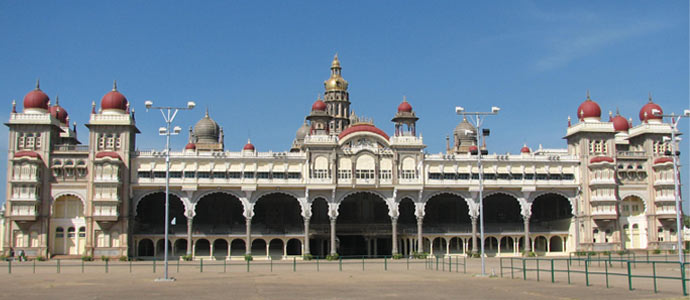About Mysore - An Introduction
Mysore city is at 770m above sea level and 140 kms from Bangalore. Also known as the City of Palaces, Mysore retains a quaint charm, that never fails to enchant.Situated in the southern part of the Deccan Plateau, Mysore District is an undulating tableland, covered in parts by granite outcrops and fringed by verdant forests. From ancient times, this district has played a significant role in the history of South India. Mysore District is a popular tourist destination, offering several attractions ranging from the royal splendour of Mysore City and its fabulous Dasara Festival to exquisite temples, pilgrimage centres and scenic spots
Taluks of Mysore
1. Mysore
2. Nanjangud
3. Periyapatna
4. Hunsur
5. T. Narsipur
6. K. R. Nagar
7. H. D. Kote
History of Mysore
The word Mysore which is derived from the word "mahishur" or "Mahishasurana Ooru", which means the town of Mahishasura in Kannada, the local language. Mysore has been associated with the Puranic story found in the Devi Bhagavatha. According to the story in the Devi Purana, Mysroe was ruled by the demon Kind Mahishasura. Mahishasura was a buffalo-headed monster. In response to the prayer by the Gods and Goddesses to save them from the demon, Goddess Parvathi, took birth as Chamundeshwari and killed the monster on top of the Chamundi hill near Mysore. Hence the hill and the city have the names Chamundi Hill and Mysore respectively.
It is said that after killing the monster the Goddess stayed on top of the hill, where she is worshipped with great devotion to this day. The famous 10 daylong Dasara of Mysore is in honour of the Goddess Chamundeshwari and is a celebration of this victory of good over evil. Before the rise of the Gangas in the 10th century there is little historical evidence relating to Mysore. The Gangas established their supremacy in the 2nd century and they ruled over a large part of Mysore till about 1004 AD. In the 3rd century they established their capital at Talakad on the banks of the river Cauvery.
There is an inscription on Chamundi Hills that was done in 950AD during the reign of the Gangas. This inscription is the oldest inscription found in Mysore. The Cholas ruled Mysore for over a century after the Gangas. The Chalukyas followed the Cholas. The Hoysalas drove the Cholas from the remaining part of Mysore region in the 12th century. Hoysala are known for the beautiful temples they built during their reign. It is said that they built or expanded the existing temples in Mysore and on the Chamundi Hills. There is an inscription in Mysore by the Hoysalas that dates back to the 11th and 12th century.
After the Hoysalas came the Vijayanagar Kings and then the Mysore Yadu dynasty came to power in 1399A.D. They were the feudatories of the Vijayanagar Kings. This dynasty also contributed to temple building in Mysore. Bettada Chamaraja Wodeyar, the raja of Mysore rebuilt the fort of Mysore and made his headquarters and called the city 'Mahishura Nagara' meaning the city of Mahishur. Many inscriptions done in the 17th century and later refer to Mysore as 'Mahishuru'. Raja Wodeyar moved the capital from Mysore to Srirangapatna. After the death of Tippu Sultan in 1799, Mysore became the capital of the Wodeyars once again.
During the reign of Krishnaraja Wodeyar III the town of Mysore expanded and moved beyond the walls of the fort. Krishnaraja Wodeyar IV developed Mysore into a beautiful city with excellent planning. Under his reign Mysore became famous for its wide roads, magnificent building and elegant parks. Today Mysore is a modern city that has managed to retain its quaint old world charm. Today Mysore in famous in the world for its sandalwood and rosewood artifacts, stone sculptures, incense sticks, inlay work with ivory and its exquisite silk sarees.
How to Reach Mysore
By Air :
Mysore has a functional airport at Mandakalli with very basic facilities. The airport is undergoing upgradation and expansion. Other airports located near Mysore are Bangalore Airport (140 km) and Mangalore Airport (250 km).
By Rail :
Mysore has a railway station with in the city and is linked by rail to Mysore and many other cities in south India. Prestigious luxury trains like Shatabdi Express and many other mails connect this station frequently.
By Road :
There is a very convenient network of roads and highways which connects Mysore to other important cities of the region. Mysore is about 140 km from Mysore, 160 km from Ooty, 120 km from Hassan and 81 km from Bandipur. There is a regular bus service for Mysore from all the important cities of the region.



 Featured eShowrooms of (New Cars)
Featured eShowrooms of (New Cars)  Featured eShowrooms of (Moblies)
Featured eShowrooms of (Moblies)  Featured eShowrooms of (New Cars)
Featured eShowrooms of (New Cars)